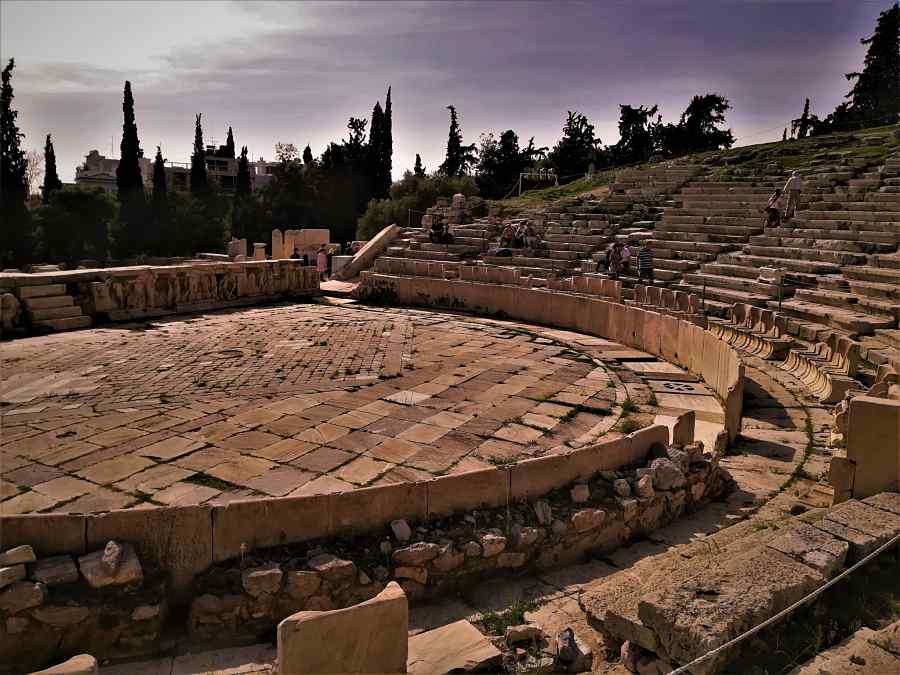This is about the largest and most important theater of ancient Greece, although it was much more than that. Located on the slope of the magnificent Acropolis of Athens, the theater of Dionysus was also the area dedicated to the God of wine and culture in Greek mythology.
Hello, traveler! I am a tour guide in Athens and welcome to this special blog. Are you interested in the the Theatre of Dionysus ? Here you will find EVERYTHING you need to know about it.

Note: This article is part of the virtual tour of the Acropolis of Athens that we offer free of charge on our website. If you do not know what this is about and want to find out EVERYTHING about this sacred enclosure (including the Parthenon, the Temple of Athena Nike, the theater of Dionysus, etc.), then you should visit the homepage.
The theater of Dionysus reached a capacity of 17,000 spectators, an excessive capacity considering that the ancient city of Athens was much smaller than it is today. However, it was not always like this, let’s see how it all began:
[toc]
History
During the era of ancient Greece, the Greeks started going to the hill ONLY to worship Dionysus. Strangely enough, the theater of Dionysus did not operate as a theater in the first place. In fact, this concept was not even thought of.
In the time of Pisistratus (Athenian tyrant of the 6th century B.C.), the first “celebrations” began to take place, whose goal was to honor their God. These included different dance and mime performances.
Sensitive information: In addition to the performances and dances, an altar was also used to sacrifice lambs in honor of Dionysus.
Over time, this place became the stage that would host the great works of the Greek authors of antiquity: the tragedies of Sophocles, Euripides, and Aeschylus, the comedies of Aristophanes, etc.
As we know it today, the theater was born in this very place—another beautiful heritage left to us by the ancient Greeks. On the one hand, we would have drama and tragedy plays for adults, while children could also enjoy mime and comedy. The performances could last up to 6 hours.
Sadly, nowadays, the theater of Dionysus is not as well preserved as we would like. Still, we can get an idea of how big it would have been in its time due to the space it occupied. Let’s find out more about what this historic theater was like and its characteristics:

Characteristics and Architecture of the Dionysus Theater
At first, the spectators were placed on wooden platforms arranged along the natural slope of the hill until the end of the 5th century B.C. Stone stands replaced these platforms.
On the other hand, the most eminent citizens had the privilege of sitting in the first row, which were made of comfortable marble seats. One of them was even more special since it was considered the throne of Dionysus himself.
Today visitors can sit on these millennial stands and enjoy this privilege as it is the only place you are allowed to enter inside the Acropolis of Athens. Let’s continue with the stage part:
As the representations became more and more complex, the altar (used for the sacrifice of the lamb) decreased in size until (thanks to God Dionysus) eventually disappeared.
The actors occupied the lowest area, called “Orchestra,” which had a semicircular shape. Behind them, they would have an element called the “scene”; this place served as a curtain to be decorated and was also used by the actors to change their masks and costumes during the performances.
But we still need to talk about the most important thing, our protagonist here? Don’t you think?
The God Dionysus
Besides being the god of wine, Dionysus was also known as the liberator (Dionysus Eleutherius in Greek). But who or what exactly did he liberate?
He was able to break down people’s normal nature, that is, to take off that mask we wear (especially in social conventions) to create a good impression. Through madness, ecstasy, and above all wine, Dionysus freed our souls and allowed us to behave as how we really are.
To put it less euphemistically: He was the one who caused us the feeling of insobriety.
Although Dionysus was a very joyful being, this God of Olympus had a tough beginning. Let’s find out about his birth, which is undoubtedly the most peculiar of all:
Dionysus was born from the union between the almighty Zeus and one of his many mistresses (Semele in this case), who was human, making our protagonist a semi-god. Hera, Zeus’ official wife, was jealous and dissatisfied for apparent reasons; so, she hatched a plan for revenge.
She lied to Semele when the latter was still pregnant, telling her that the man she slept with was NOT really Zeus. The mistress wanted to get out of doubt and asked Zeus to deny this accusation by showing himself as he really was since the God adopted a human form when he had relations with these women.
At first, Zeus refused this request. However, because of Semele’s insistence, He finally turned into a thunderbolt and showed her all his power. – But of course, which ordinary human being is capable of surviving in such a condition? – Well, none of them… The mistress was instantly struck down.
What about the baby?
Fortunately for Dionysus, Hermes (the messenger-God) managed to save Dionysus from the woman’s dead womb and insert it into Zeus’ thigh (!). After the remaining three months of pregnancy, the baby was born (again) out of his father’s leg. It is for this reason that Dionysus is also known as “the twice-born.”
His youth was not easy either, as he grew up hiding from his stepmother, who was still seeking revenge for Zeus’ infidelity. In the beginning, Dionysus lived in disguise and was raised as a girl by foster parents. His biological father insisted that this was so in order to try to deceive his wife until Hera discovered them. At that moment, Zeus was forced to expel his son out of Greece and turn him into a little goat that the nymphs would take care of.
This exile and the subsequent travels would make Dionysus also known as “the foreigner.”
As you can see, and despite what many people know, this God was much more than someone who liked wine and “partying.” Keep this in mind when you visit the theater of Dionysus.
Congratulations, traveler, on reading this far! You’re definitely getting ready to make the most of your visit to the Acropolis of Athens. You can now skip to the next monument and continue with our virtual tour. Otherwise, you can also continue reading the “frequently asked questions about the “Theater of Dionysus” (after this paragraph) or return to the main page.
